For more than 30 years, the AGJV has contributed to research and monitoring projects that facilitate improved understanding and management of geese. Much of the work occurs in the Arctic and would not be possible without remote field camps, established and operated cooperatively by governments and the flyways. It is hard to imagine the logistics of constructing and maintaining safe, habitable accommodations near major goose colonies in areas with extremely limited access, harsh weather and polar bears. The history of these camps is remarkable.
Thanks to the hard work of many, these camps have evolved over the years as they support a wide range of new research, while maintaining their core focus on geese. Collectively, as of 2019, about 1 million geese have been banded at these camps and more than 700 publications have resulted from the studies done by hundreds of people from across North America and Europe. As well as hosting seasoned researchers, these camps have played a vital role for students being trained in arctic field research and exposed to scientific studies.
For more information about these and other northern research camps, please see the Canadian Network of Northern Research Operators (CNNRO) website/network of sites.http://cnnro.ca/
Goose Field Camp Map
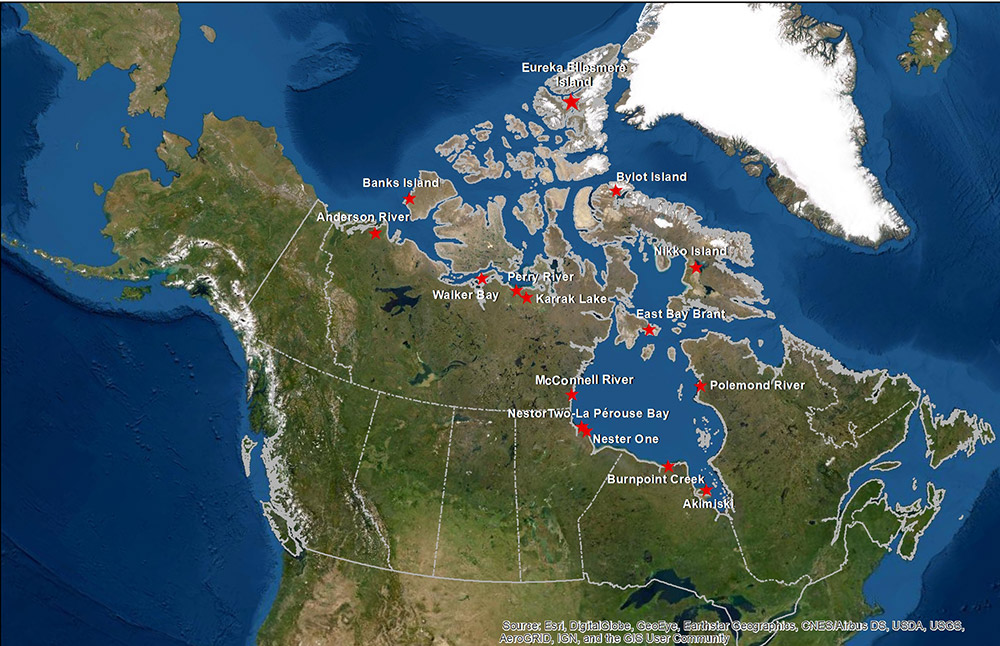
East Bay Brant Camp, Southampton Island, Est. 1957
East Bay, Southampton Island, has been the site of goose studies since 1957 when it was first used to study American (now Atlantic) Brant. It was also used in 1979, 1980, 2010, 2014 and 2015. The focus has been on the breeding biology of brant through all these years but the other goose species that nest there (lesser snow, cackling and Ross’s) have also been studied and monitored. It is the only location in the range of the Atlantic Brant from which the details of nesting have been consistently collected. Goose habitat studies were conducted there from 2010 to 2015. All camps were seasonal tent camps supporting from 2 to 8 researchers depending on the year of study. The pioneering brant researcher marked his 1957 camp site with a cairn that is still standing. He also wrote a message on the side of the camp esker using slabs of limestone and it is still visible. His message was a communication about the success of the breeding season intended for the occupants of an aerial survey aircraft that was passing over to check on his status. The message read (in part): BAD YR FEW YG GEESE.
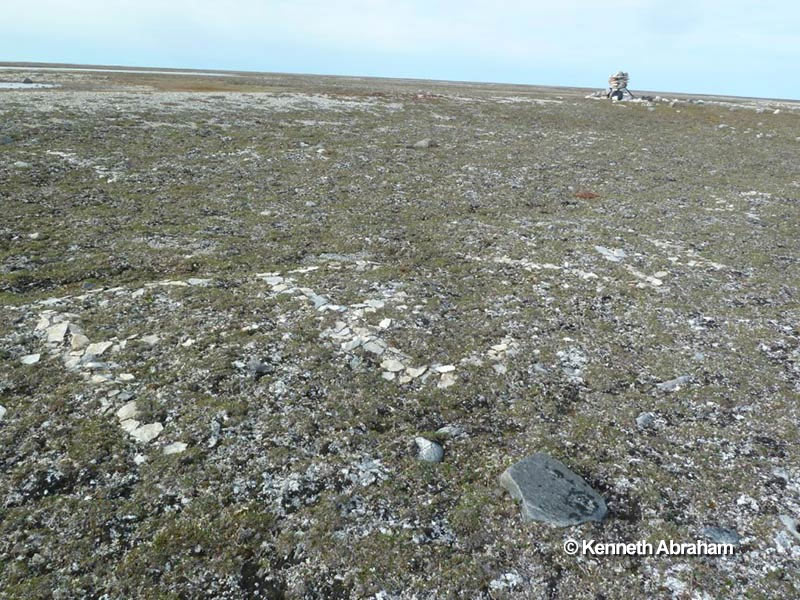
1957 Cairn marking the East Bay Brant Camp & partial message in limestone.
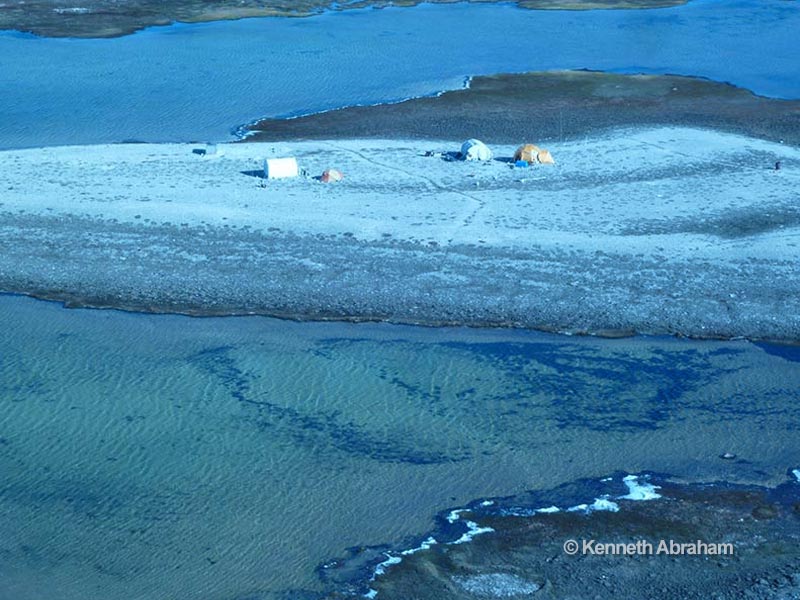
Aerial view of East Bay Brant Camp in 2014.
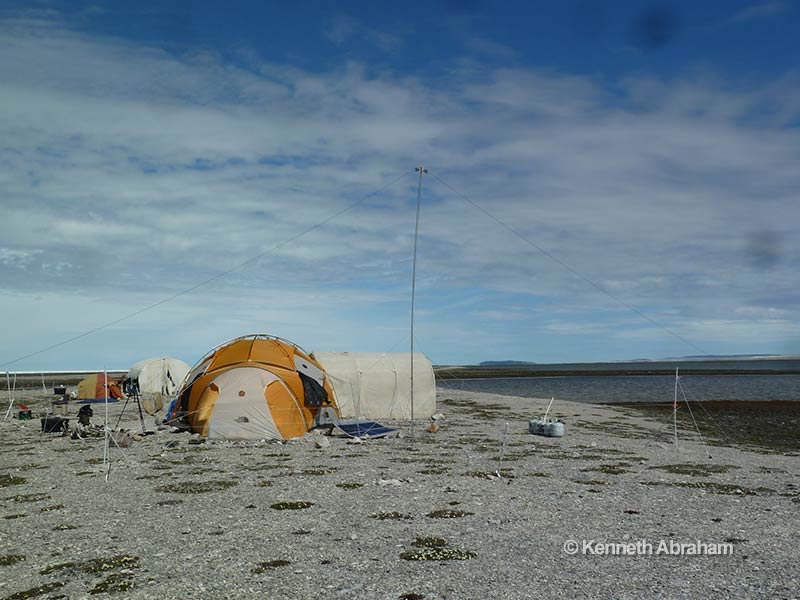
East Bay Brant Camp in 2014.
McConnell River, Est. 1958
Goose research has been undertaken periodically at and near the McConnell (Kuugaarjuk) River Migratory Bird Sanctuary, beginning with snow and Canada goose banding in 1958. Seminal work on the small Canada goose (now cackling goose) and the lesser snow goose was conducted between 1958 and 1973. It included feeding and food habits of both species, energetics of reproduction of lesser snow geese, population structure and behaviour. Banding involved use of individually coded neck bands, the first such work in the Arctic, which allowed tracking of individuals over many years yielding original information on fidelity to nesting and brood rearing sites, pairing relationships, family membership and use of staging and wintering sites throughout the range. The largest goose banding project in the world was conducted in 1977 and 1978, with over 25,000 lesser snow geese banded in 1977 and over 50,000 banded in 1978! The recent banding effort continued until 2007. Habitat evaluation conducted in the late 1970s to mid 1980s revealed evidence of the first chronological instance of over-grazing by lesser snow geese. Habitat classification was also conducted. Another camp was set up on the north side of McConnell River near Disappointment Lake in 2003, and served as the base for research on a rapidly growing colony of Ross’s geese, and sympatric nesting cackling geese. Research and banding continued until 2007.
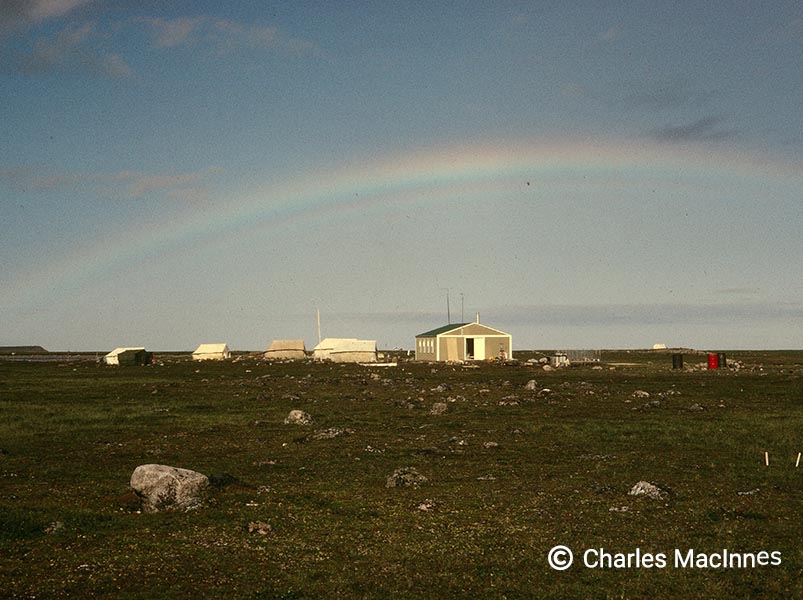
McConnell River Building and Camp in 1967
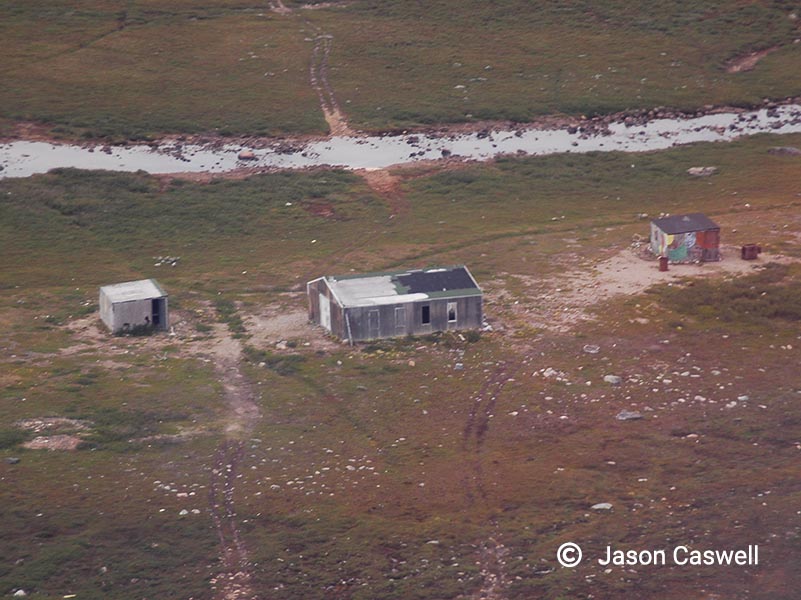
Aerial view of McConnell River Camp, early 2000’s
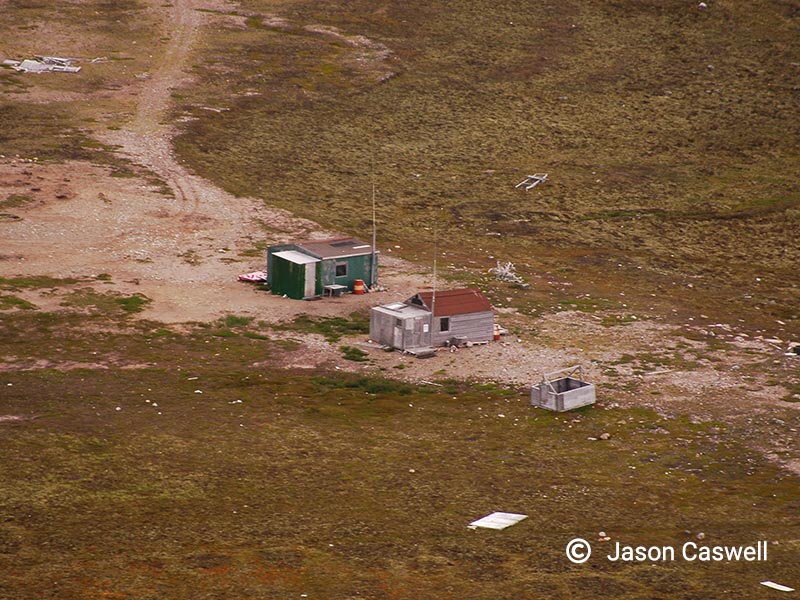
Aerial view of camp on north side of McConnell River near Disappointment Lake, early 2000’s
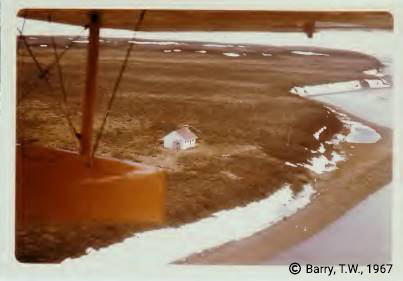
Barry, T.W., 1967. Geese of the Anderson River Delta, Northwest Territories (Doctoral dissertation, University of Alberta, Edmonton, Canada)
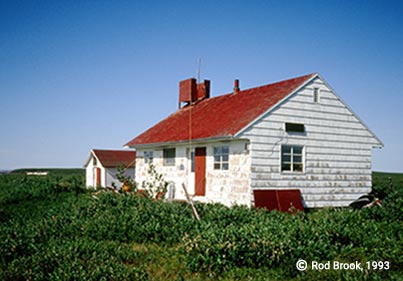
Anderson River NWT CWS research station 1993
Anderson River, Est. early 1960s
The house at Krekovic Landing, along the Anderson River, was built in 1947 for reindeer herders using the area. It was subsequently acquired by the Canadian Wildlife Service and used for Brant, Snow goose, White-Fronted goose, Grizzly bear, and habitat studies from the 1960’s to the early 2000’s. An observation blind was built on the roof to allow direct observation of breeding geese. While occasionally used temporarily by canoeists or hunters passing through, the camp has not been used by researchers since the early 2000s and was in need of major repairs as of 2009. The camp is located approximately 100km east of Tuktoyaktuk, NT.
Perry River, Est. 1964
Built in the summer of 1964, Perry River camp is located in the Queen Maud Gulf Migratory Bird Sanctuary along the east side of Perry River. The east side expansion was added to the cabin in 1975. It has been used by several researchers over the years and now is primarily used for goose banding a few weeks per year.
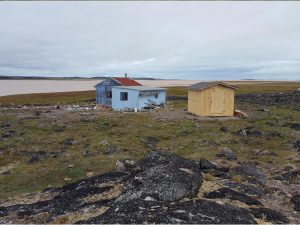
Perry River Cabin
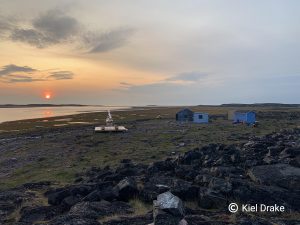
Perry River Camp in 2019
Nester One, Est. 1967
This camp was established in northern Manitoba to study Canada Geese nesting along the Hudson Bay coastline. Nester One was named for its “goose nesting” radio call sign. The original camp consisted of a Quonset hut and an outhouse that was regularly destroyed by polar bears. For many years, a Churchill resident transported supplies on his Bombardier tracked snow machine, hauling everything from aircraft fuel and heating oil to groceries and building supplies (including the kitchen sink), and in all kinds of weather.
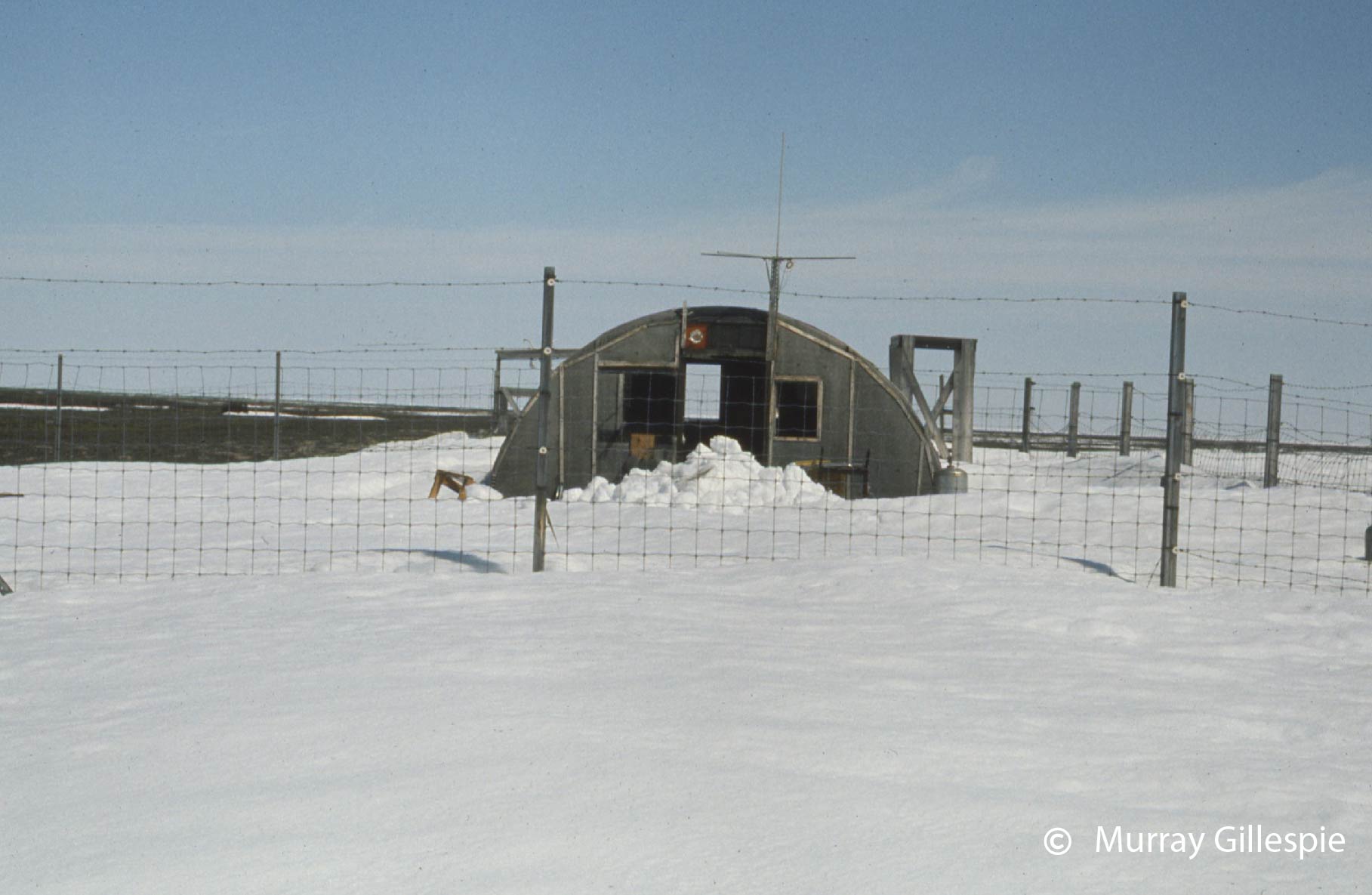
Nester One Camp in 1976
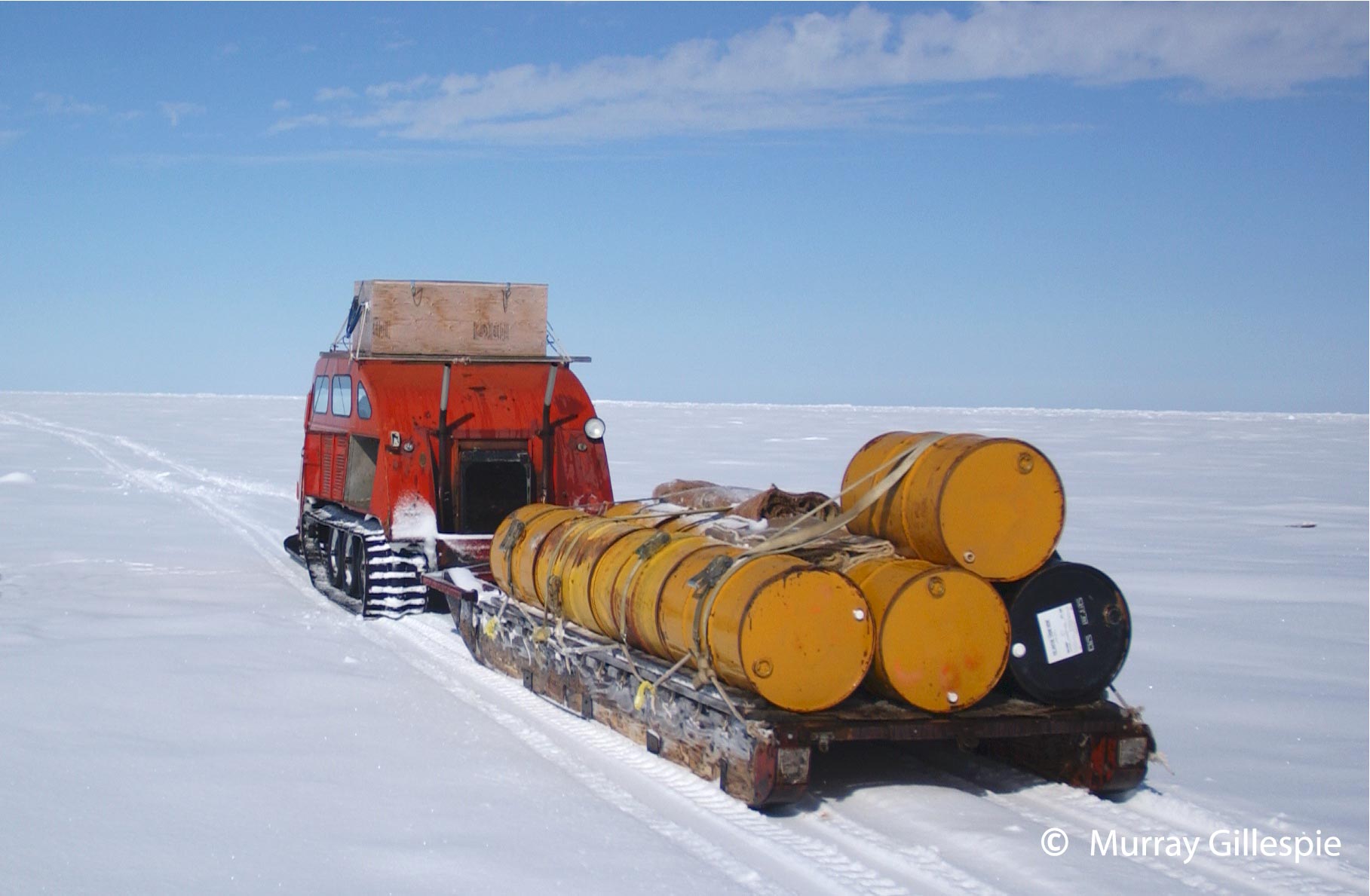
Supplies en route to Nester One Camp in the early 1970s. One of the earliest records of banding in northern Manitoba is from 1956 when scientists used freighter canoes and herded goose broods on foot!
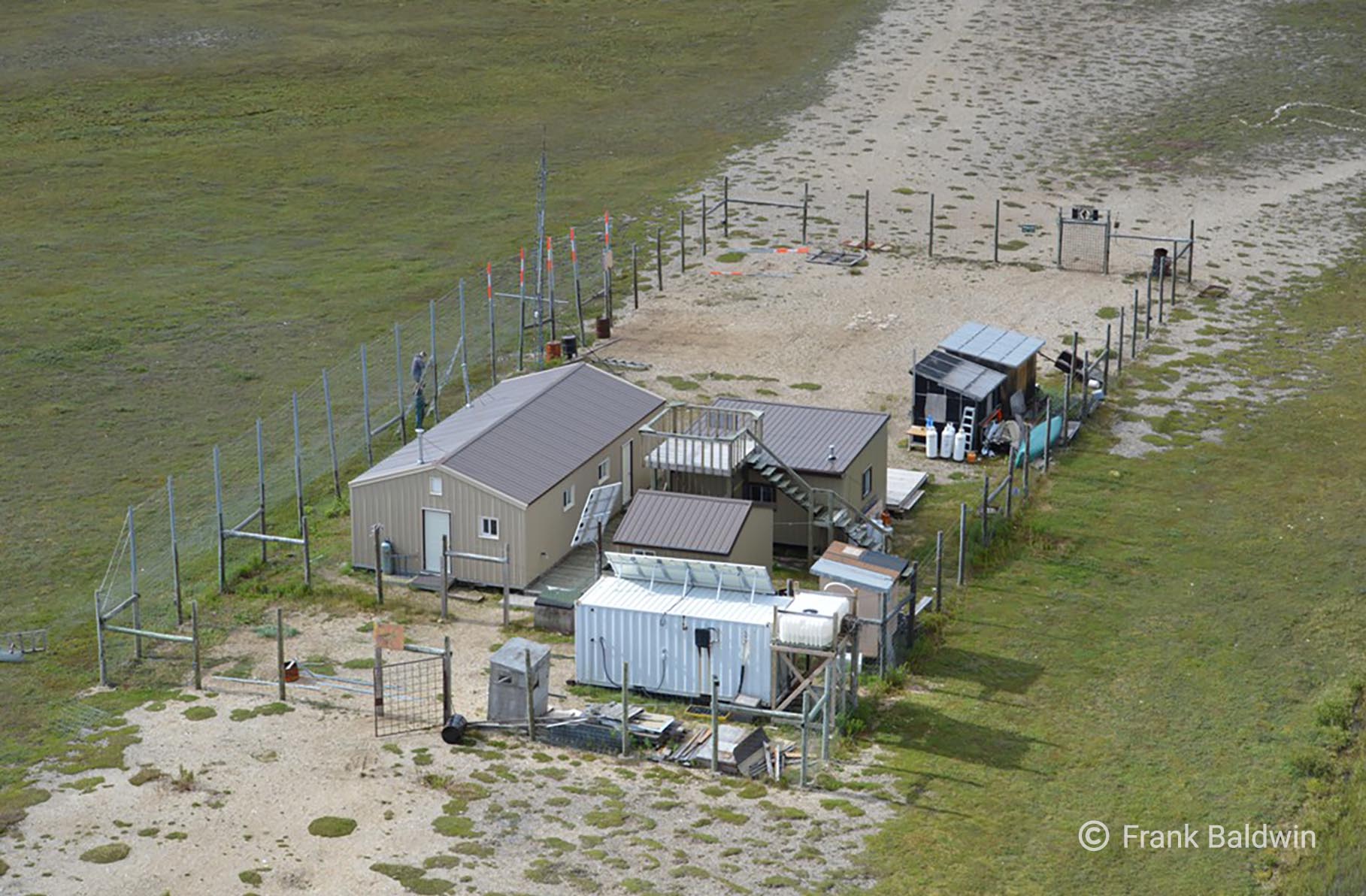
Nester One in 2017
Nestor Two – La Pérouse Bay, Est. 1968
Originally named to distinguish it by radio from Nester One, this camp was established to study the Snow Goose colony at La Pérouse Bay, Manitoba. The Snow Goose research at the camp focused on the complete life history including genetics of colour, mating systems, population structure and survival. From 1979 to present, research has expanded to include goose–plant interactions of the Hudson Bay coastal ecosystems. Starting as a single building, the camp now includes several buildings and has been used for long-term studies of Common Eiders, Willow Ptarmigan, Savannah Sparrows, Polar Bears, numerous shorebirds and aquatic invertebrates.
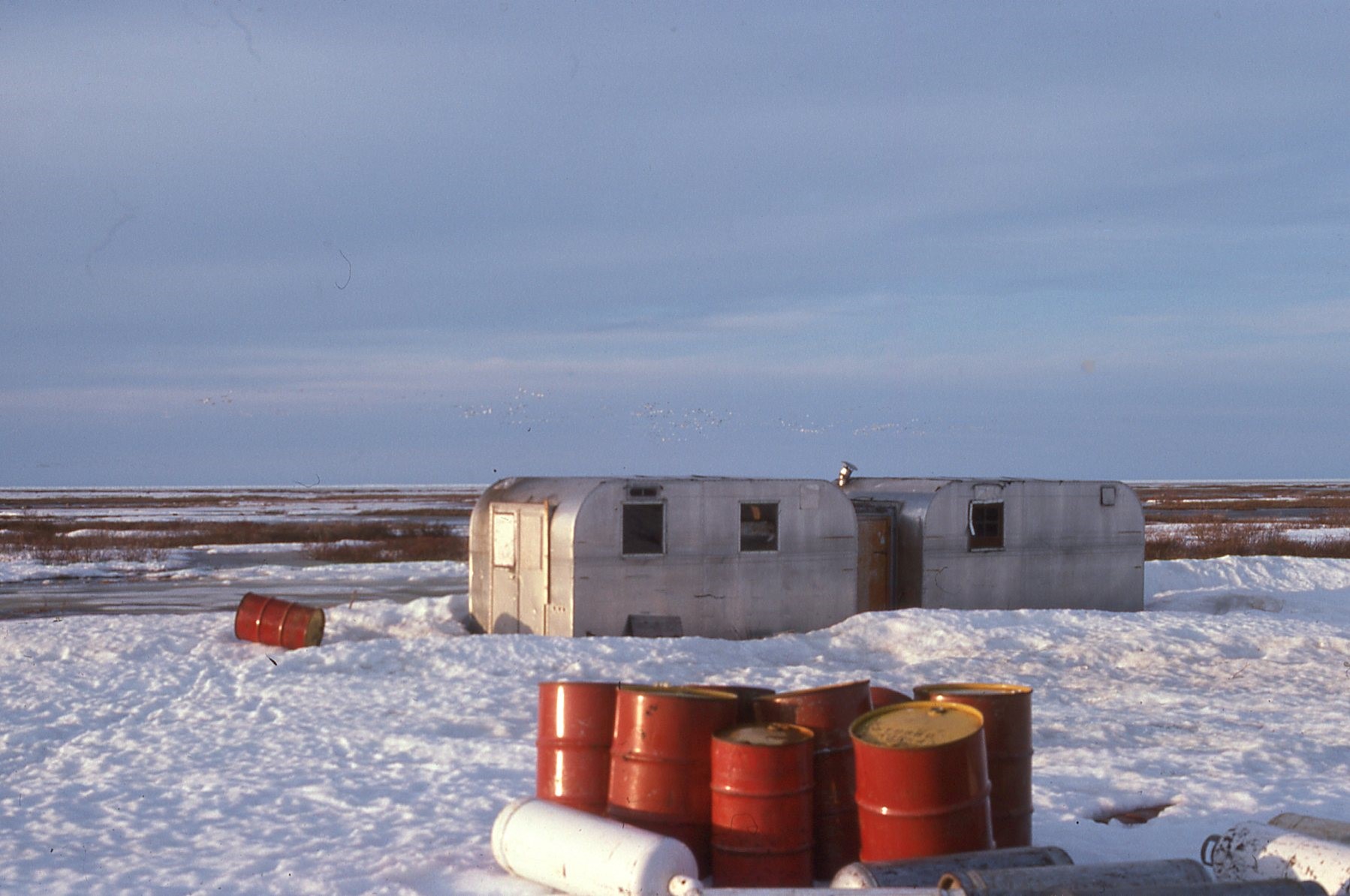
Sleeping Quarters in the 1970s
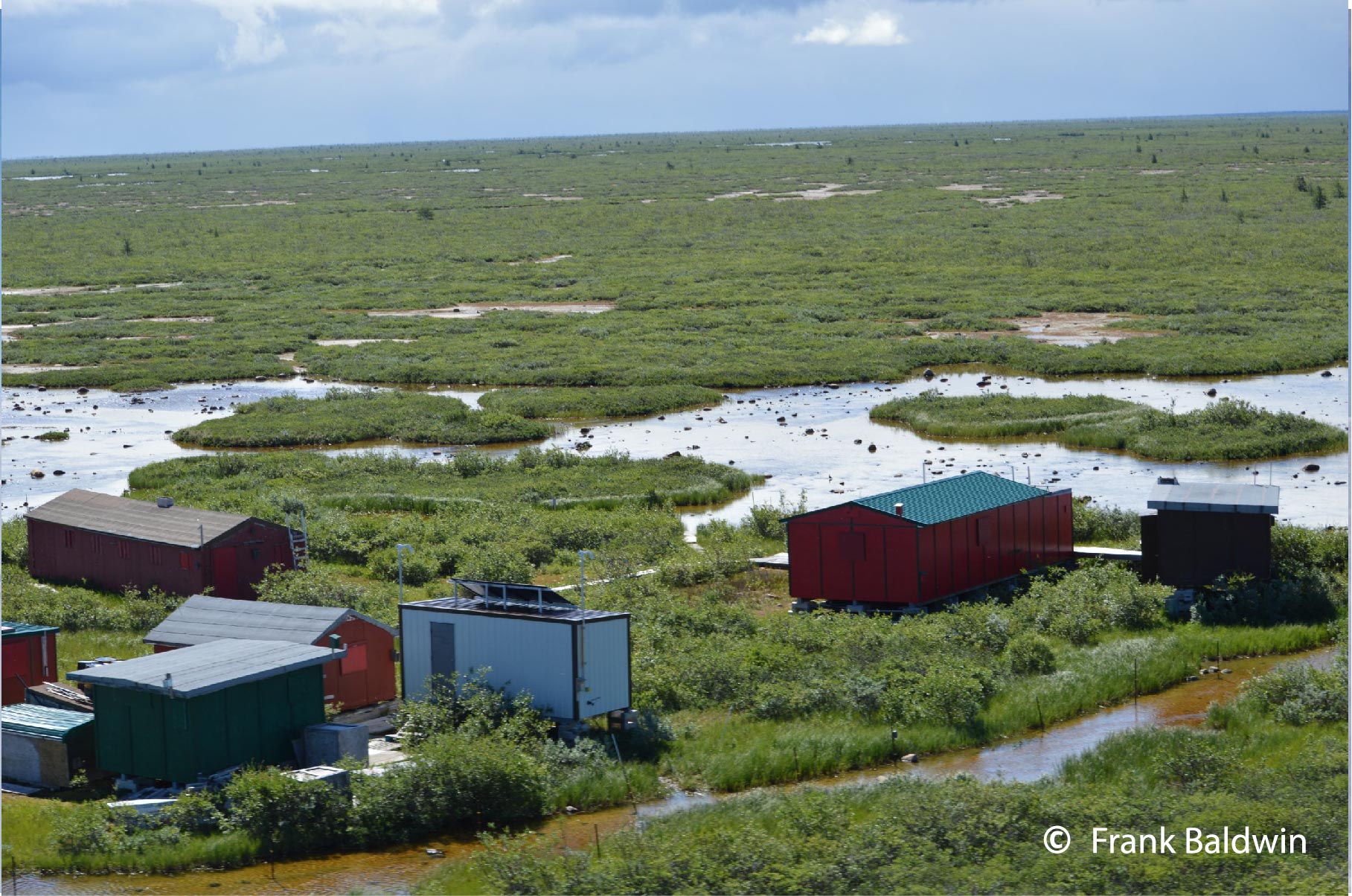
Nestor Two – La Pérouse Bay Field Camp in 2017
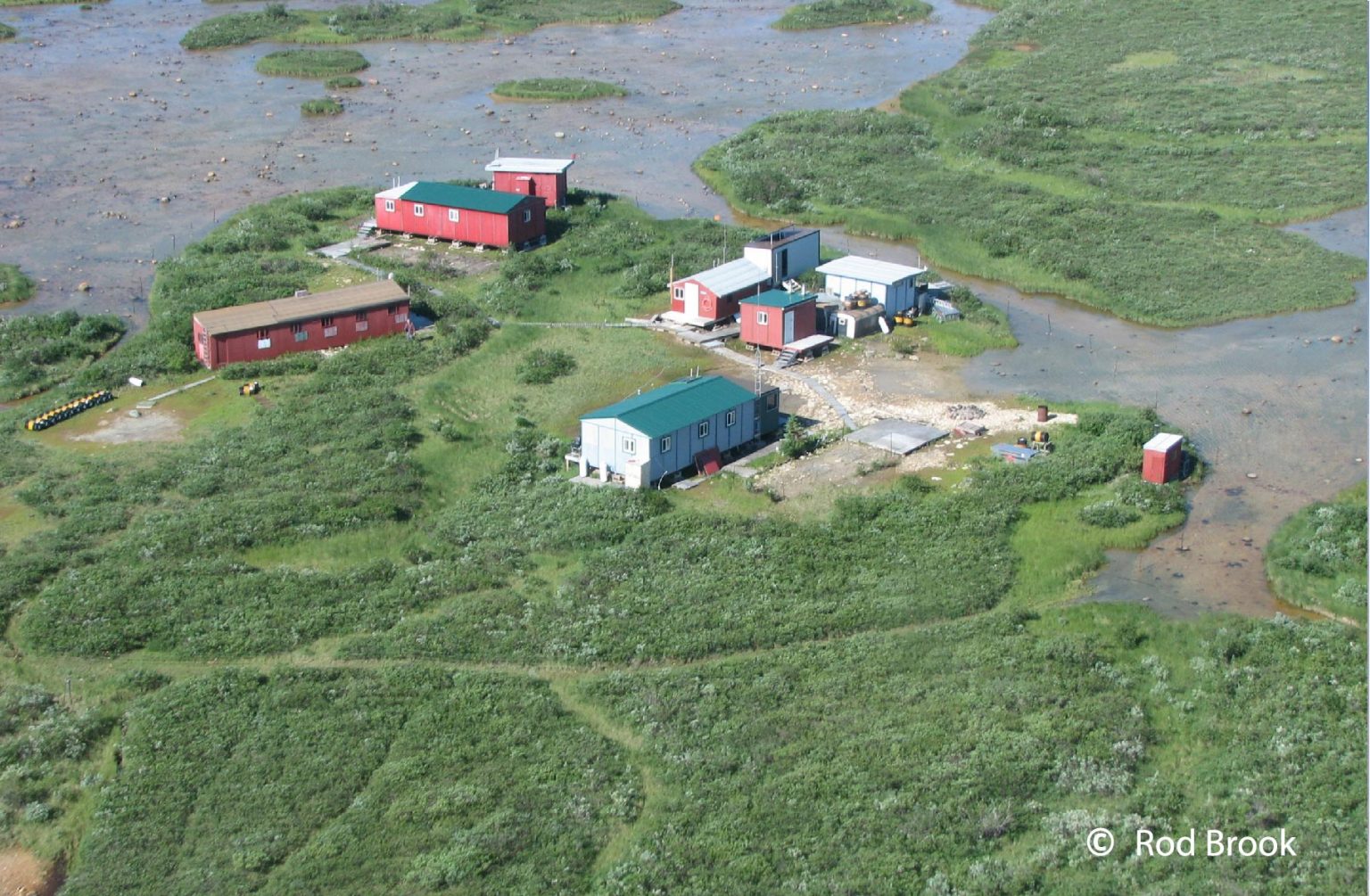
Nestor Two – La Pérouse Bay Field camp aerial view
Akimiski Island, Est. 1980
Located on the coast of James Bay, Nunavut, Akimiski Island was initially a tent camp for Canada Goose banding. In 1993 it was expanded to monitor annual nesting biology and gosling survival, and research there has broadened to cover community ecology questions including goose-plant interactions, shorebird breeding and migration ecology, and invertebrate diversity and abundance.
The now-permanent camp has plywood cabins and a helicopter landing area, all surrounded by secure “zoo” fencing to protect both crews and helicopters from polar bears. While coastal fog is often a challenge for aircraft—typically a Twin Otter or helicopter arriving from Moosonee, Ontario, approximately 140 miles (225 km) away—polar bears command the most attention.
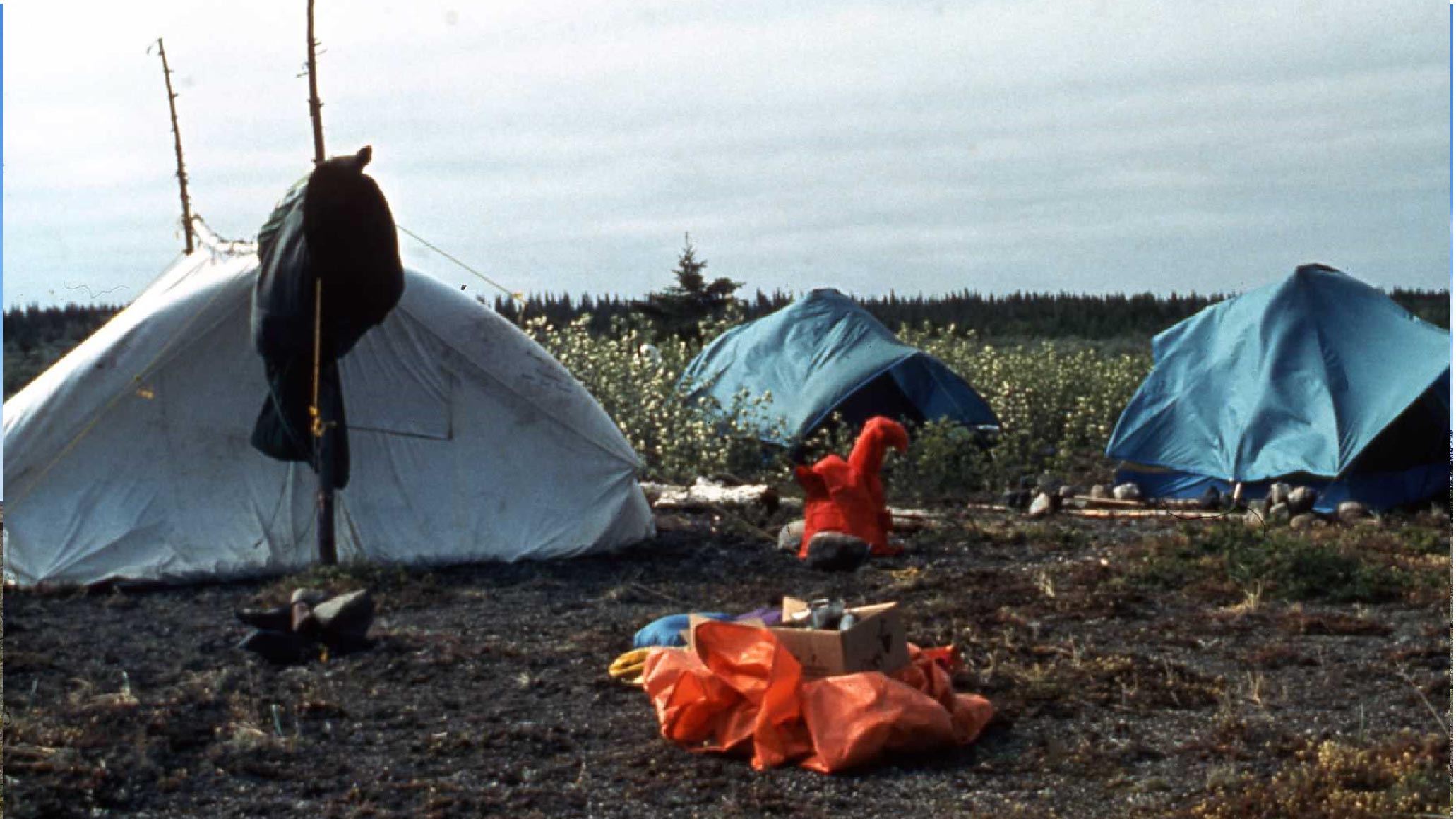
Akimiski Tent Camp in early 1980s
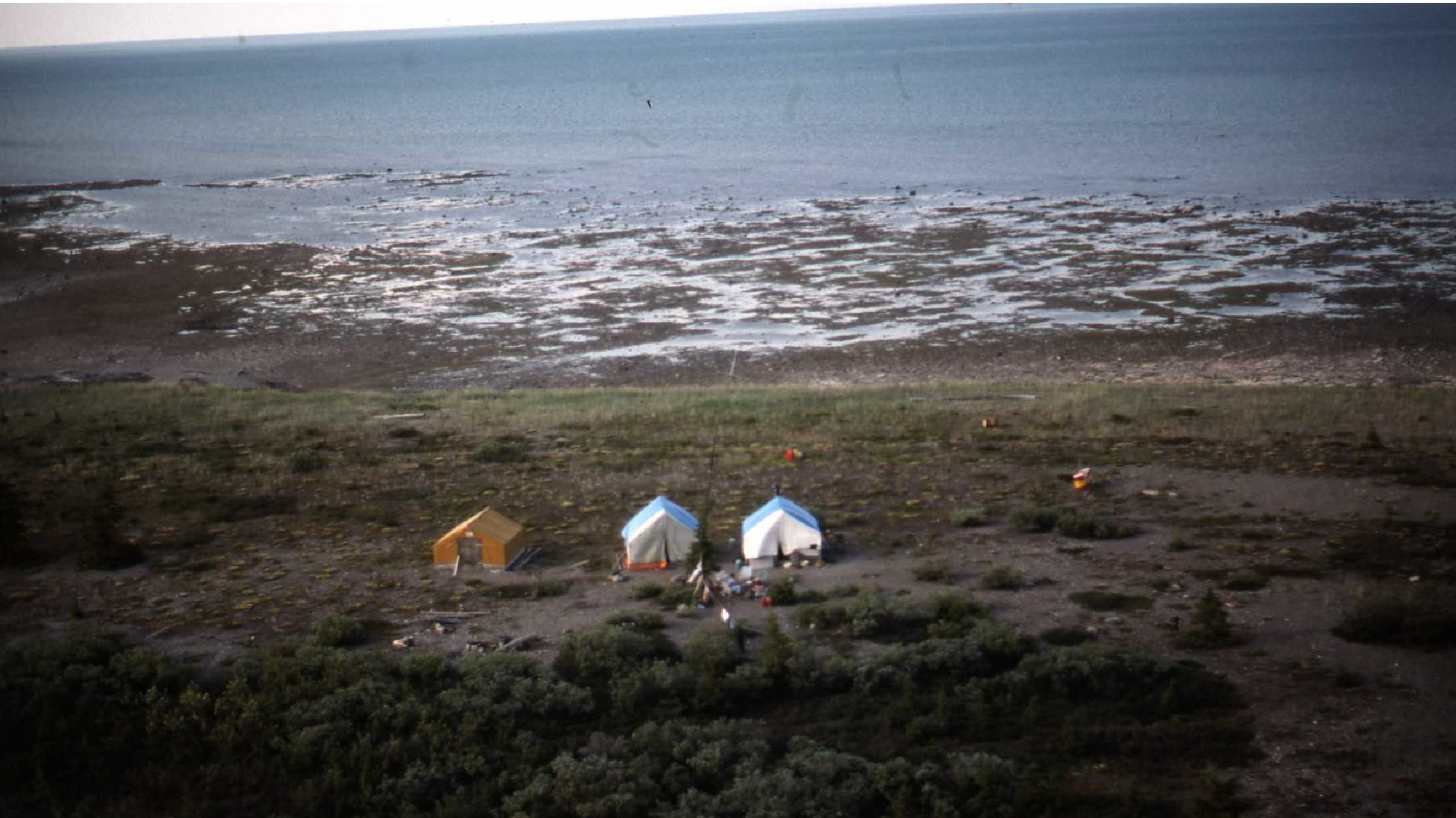
Akimiski Camp in 1990
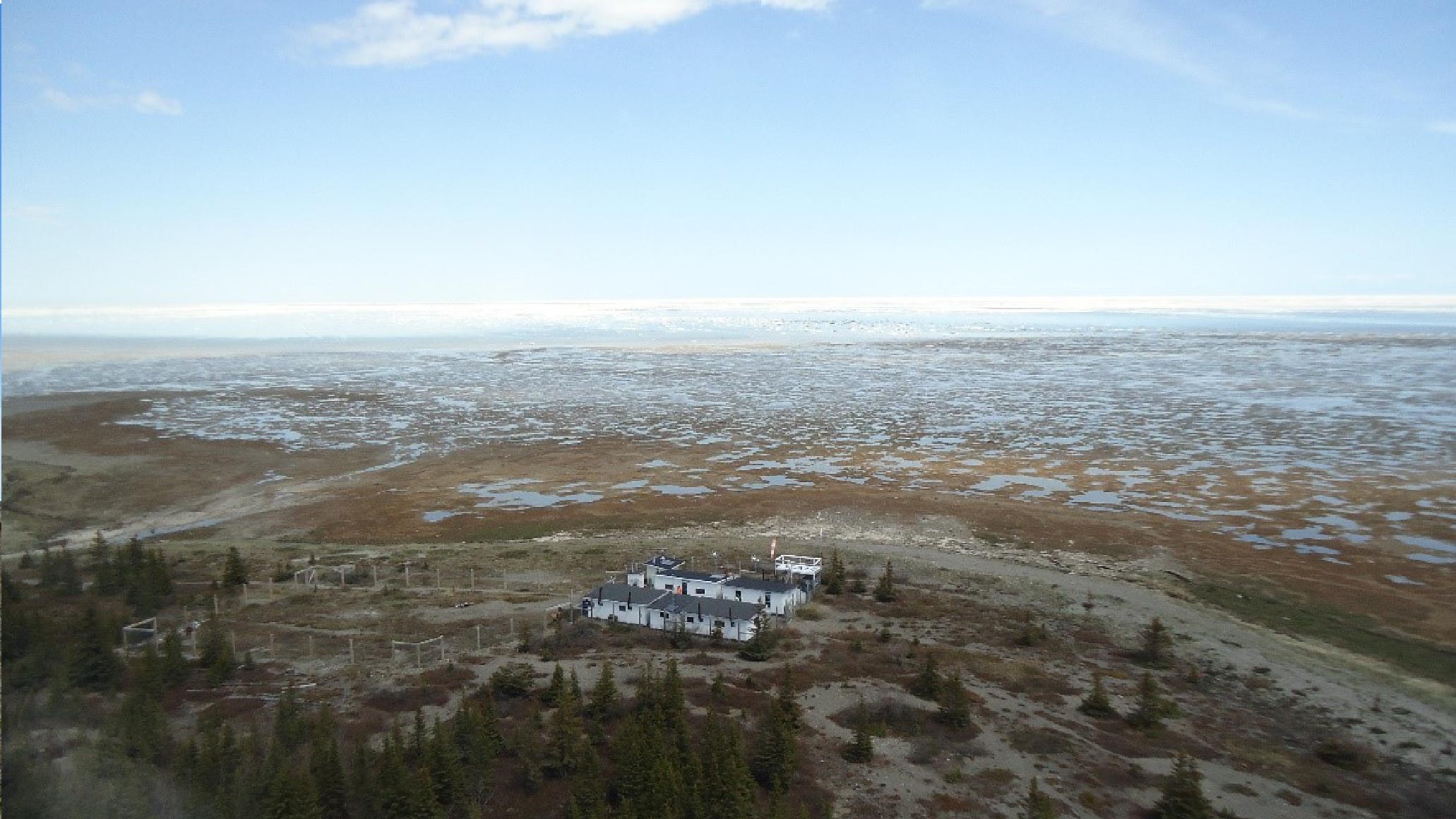
Akimiski Camp with zoo fencing helicopter compound (left of camp), 2015
Nikko Island, Est. mid-1980s
Arctic Char research was the reason for this camp being established about 185 miles (300 km) northwest of Iqaluit on Baffin Island, with goose research beginning in the mid-1980s and goose banding annually since the early 1990s. The camp infrastructure was given a major face lift beginning in 2005.
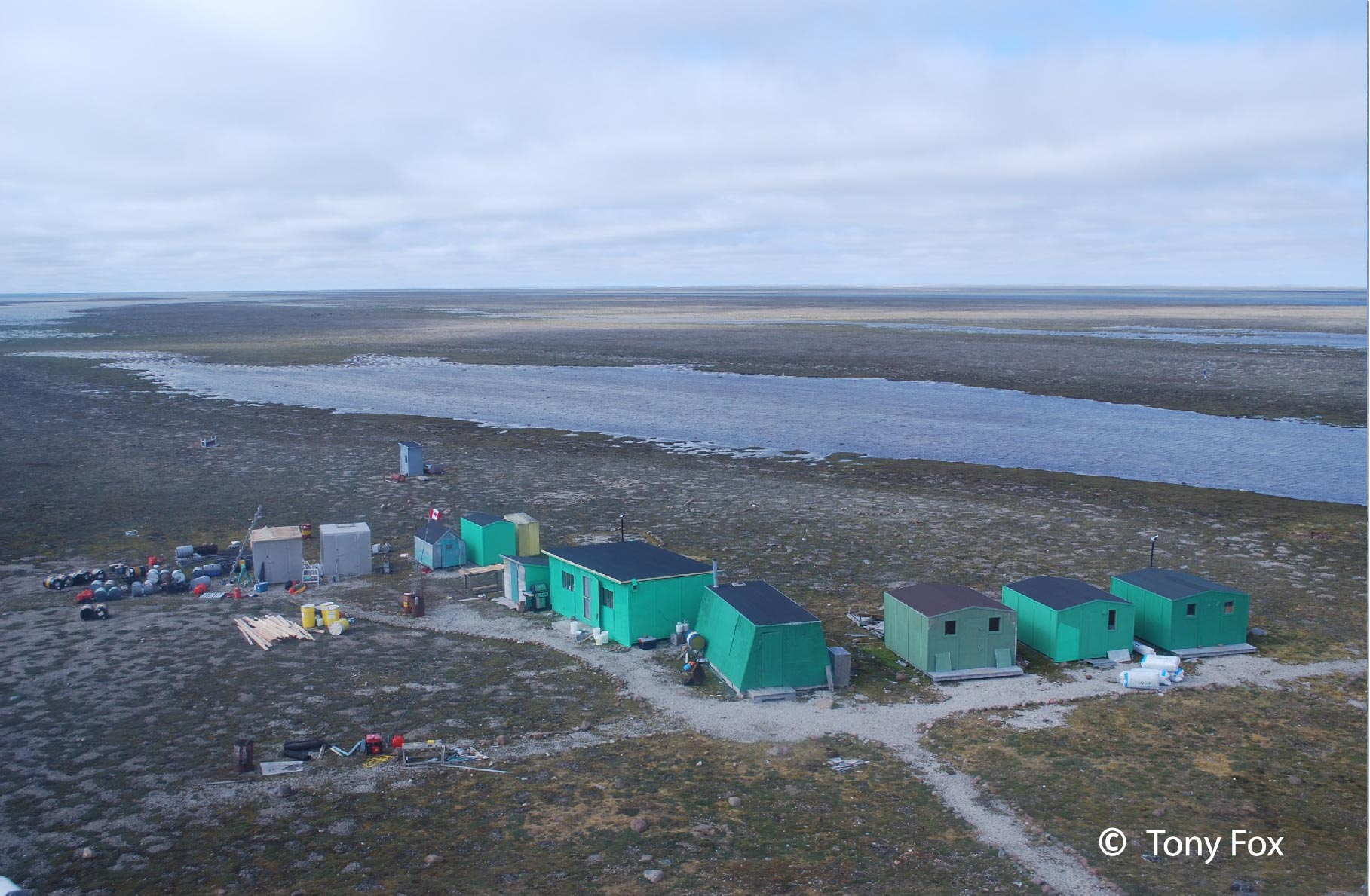
Nikko Island Camp in 2015.
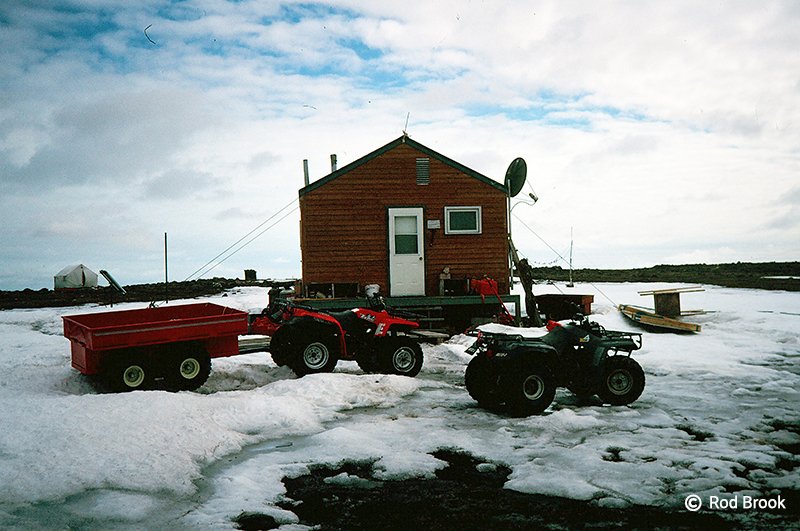
Walker Bay Research Station.
Walker Bay Research Station, Kent Peninsula, Est. 1986
Research at the site was initiated in 1986 where the current Walker Bay Research Station (Kent Peninsula) cabin was built in 1989 by the Government of the Northwest Territories (GNWT prior to creation of Nunavut). Goose studies were conducted throughout the 1990s, and were primarily focused on Canada geese and White-fronted geese. Studies included predator impacts on goose productivity and small mammal studies. The facility is still available and can be used for research or education programs by contacting the Government of Nunavut (http://cnnro.ca/walker-bay-research-station/).
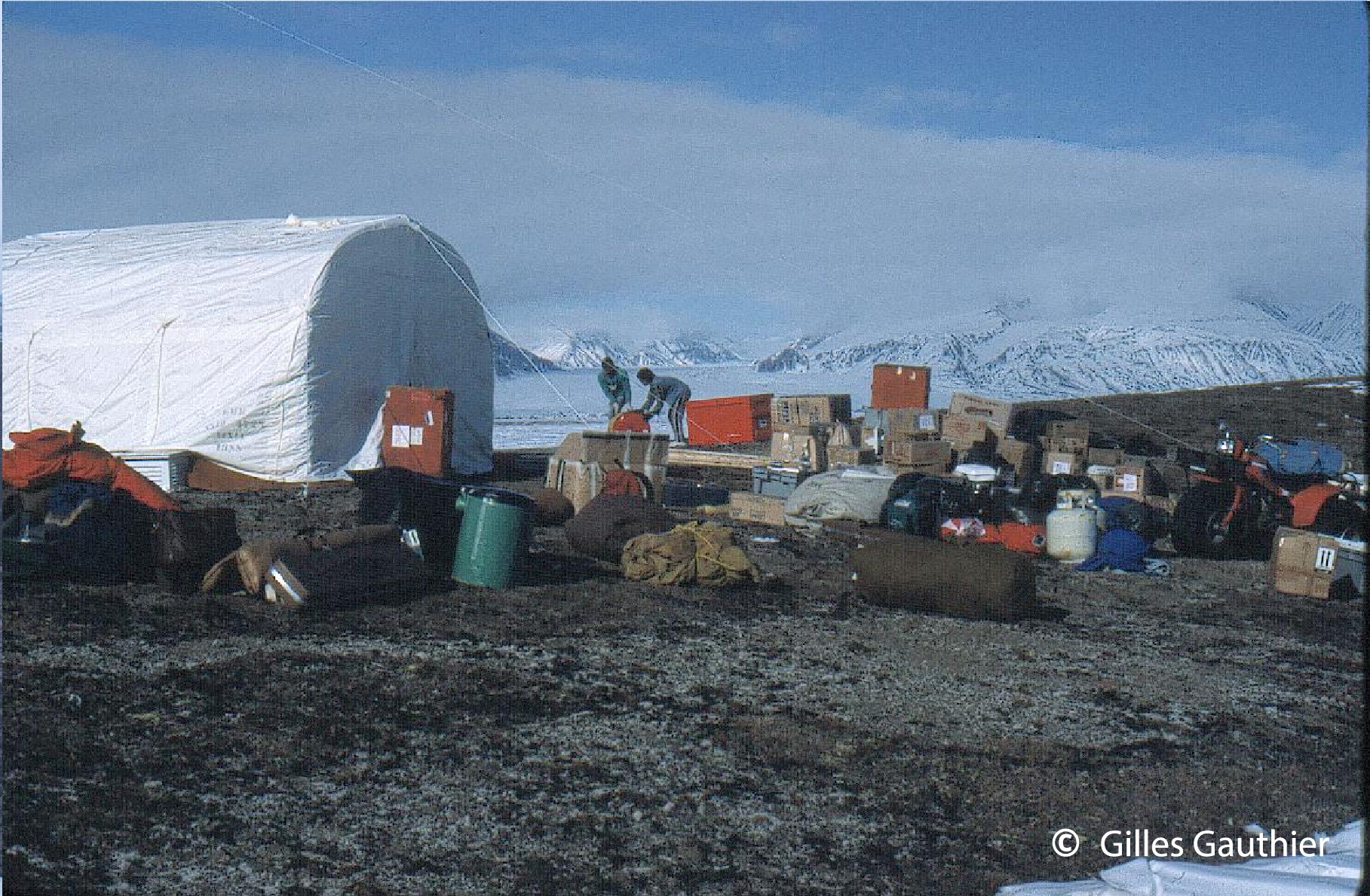
Bylot Island Camp in 1989
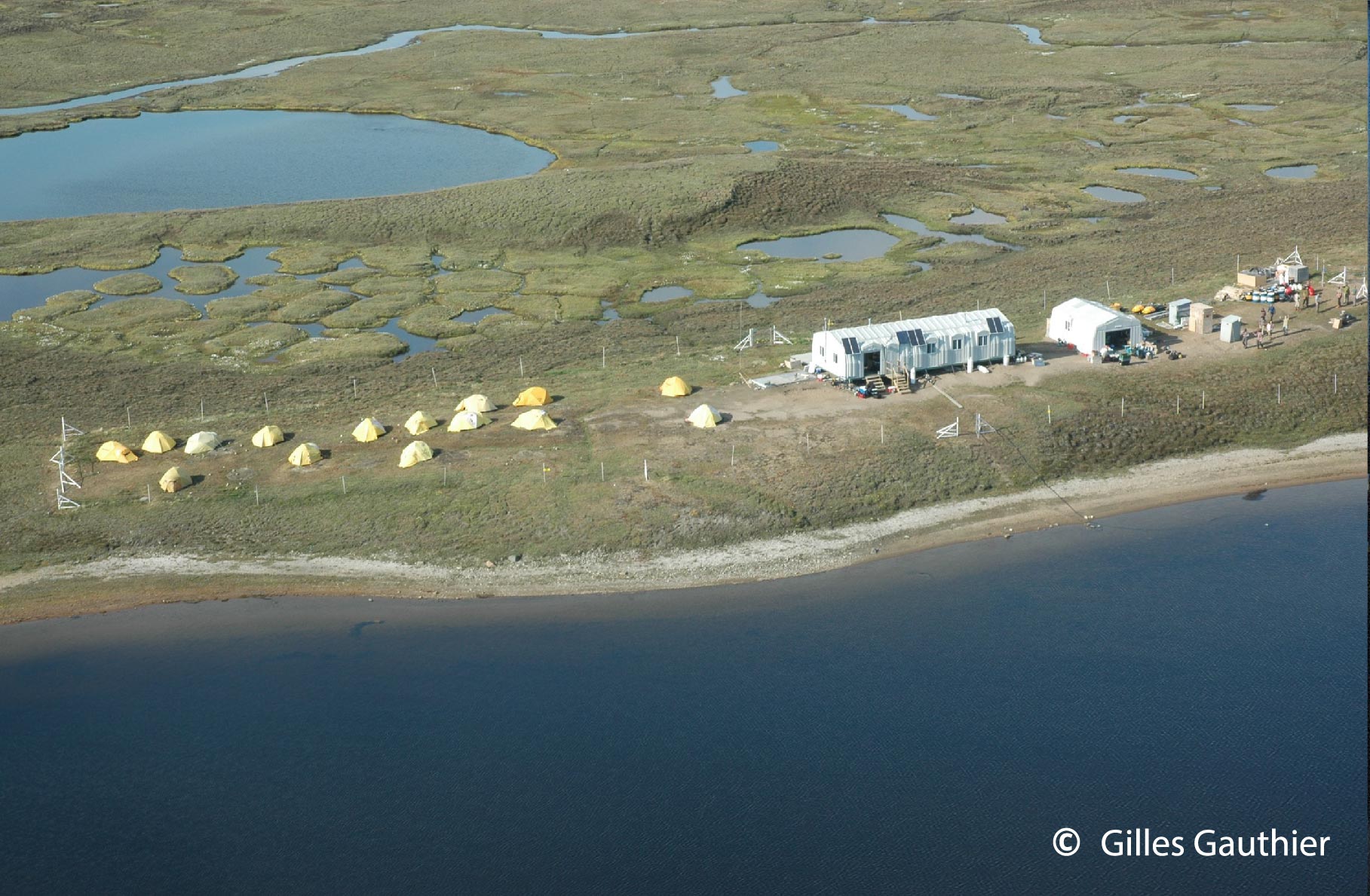
Bylot Island Camp in 2019
Bylot Island, Est. 1988
Established in collaboration with Laval University, this camp is within Sirmilik National Park and Bylot Island National Wildlife Area. Each year, dozens of Canadian and international researchers arrive by helicopter from Pond Inlet (Mittimatalik), Nunavut, 52 miles (84 km) away. As a member of national and international research networks, the camp serves a wide research domain: animal ecology, botany, plant monitoring, cryospheric (permafrost, snow) studies, hydrology, limnology, carbon cycling and climate impacts on the ecosystem.
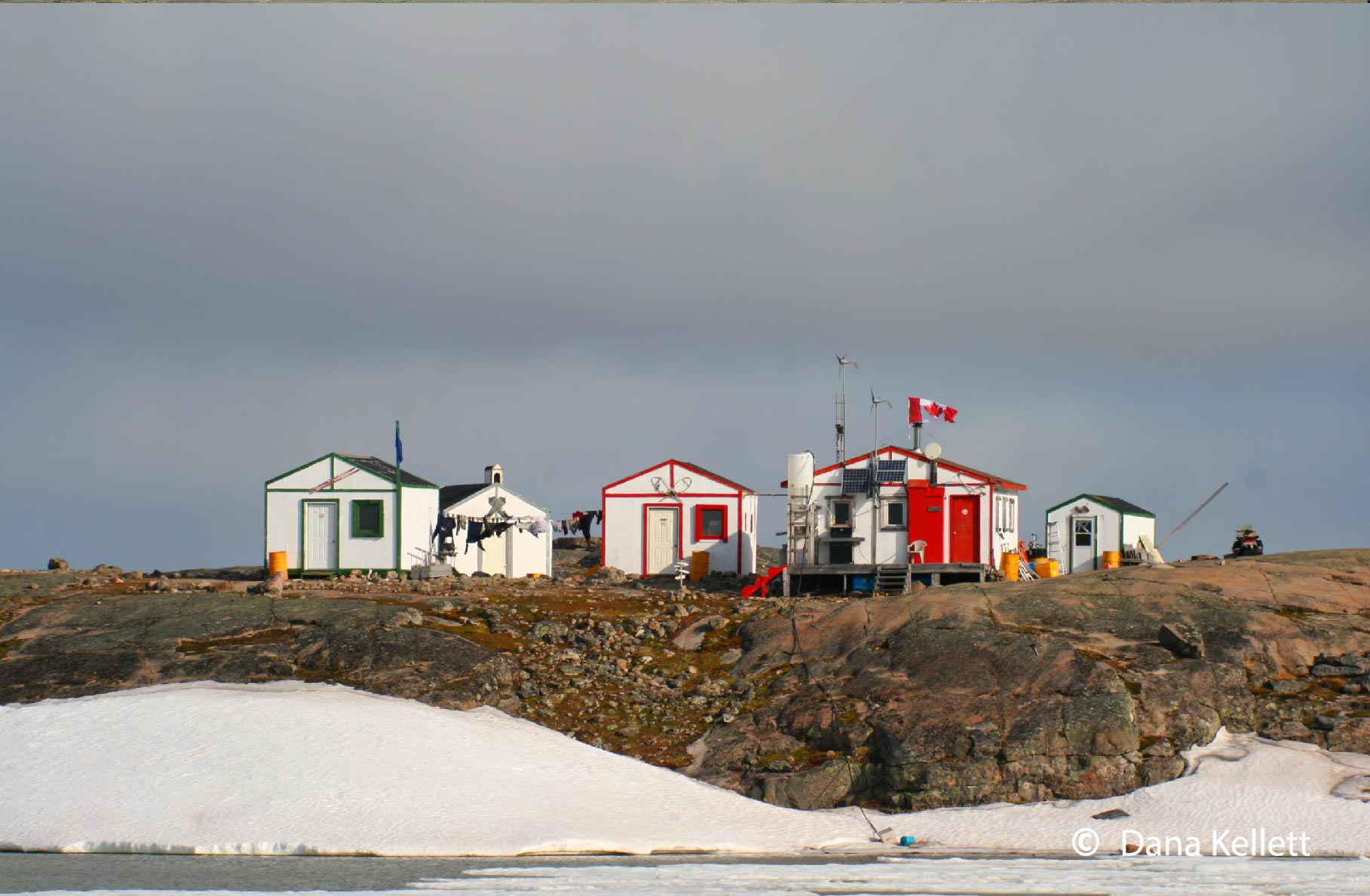
Karrak Lake Camp in 2009
Karrak Lake, Est. 1991
Karrak Lake Research Station is located on the largest island in Karrak Lake, in Queen Maud Gulf Migratory Bird Sanctuary about 185 miles (300 km) southeast of Cambridge Bay, Nunavut. This research station was established in 1991 and began as a main cabin plus two frame tents and now has six buildings. The first boat used to ferry people and supplies to and from the Island was constructed of blue plastic barrels and a sheet of plywood. Research at Karrak Lake has evolved into an ecosystem approach: breeding and population ecology, species interactions, environmental influences on population demographics and trophic interactions.
Banks Island, Est. 1992
The main Banks Island camp is located on the shore of SikSik Lake, approximately 60 Km north of Sachs Harbour, NT. It consists of two wooden tent platforms on which canvas tents are set-up for cooking and storage. Additional tents are set-up for sleeping. The camp has been used for brant, snow geese, king eiders and shorebird research, as well as habitat studies since 1992.
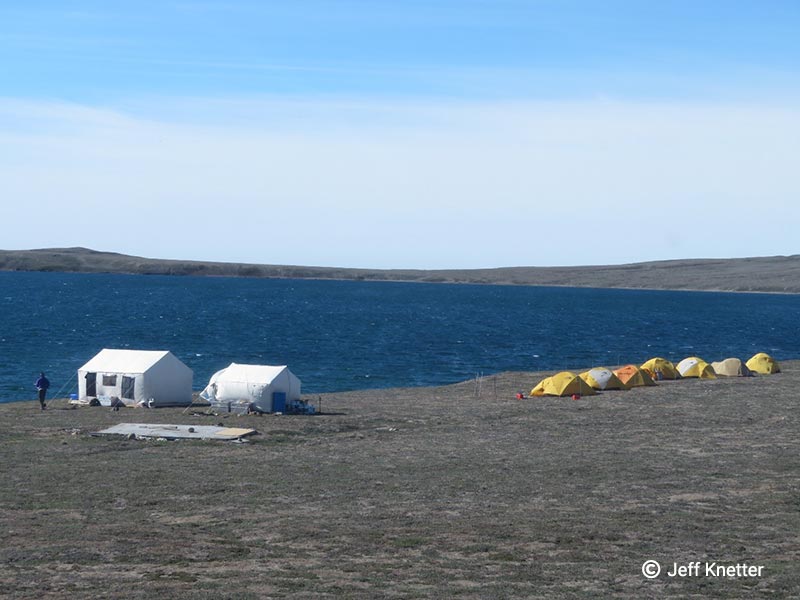
Banks Island
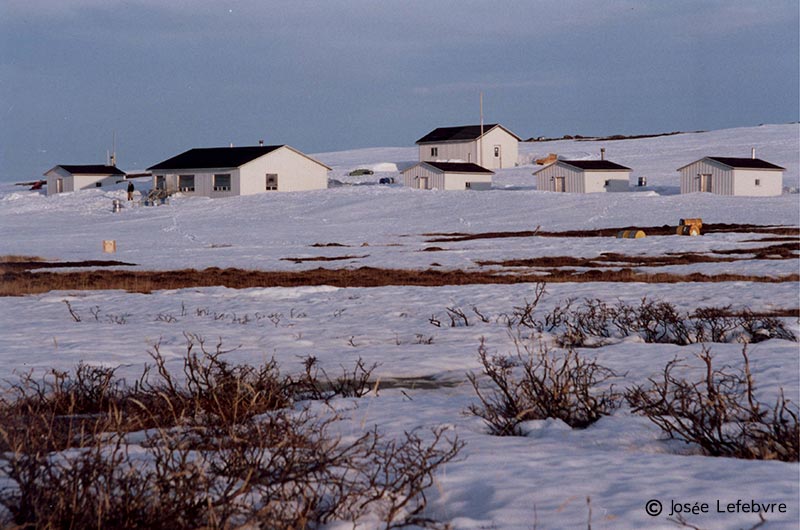
Polemond River, Est. 1997
Polemond River, Est. 1997
The Polemond River goose camp is located approximately 60 km south of Puvirnituq on the Hudson Bay side in Nunavik, at Tuksukatuk River Lodge. Canada goose nesting and productivity monitoring was carried out intensively from 1997 to 2003 and banding activities from 1996 to present. During the intensive monitoring, small mammals studies and habitat productivity were also conducted.
Burntpoint Creek, Est. 2000
Burntpoint Creek research camp was built in 2000 and was first used for Canada Goose nesting ecology work in 2001 and Canada and Snow Goose banding from 2001-2007. Since 2007 research there is ecologically broad-based with monitoring of Southern Hudson Bay Canada geese and studies of shorebird ecology, including marking and telemetry projects, invertebrate diversity and abundance, and permafrost dynamics.
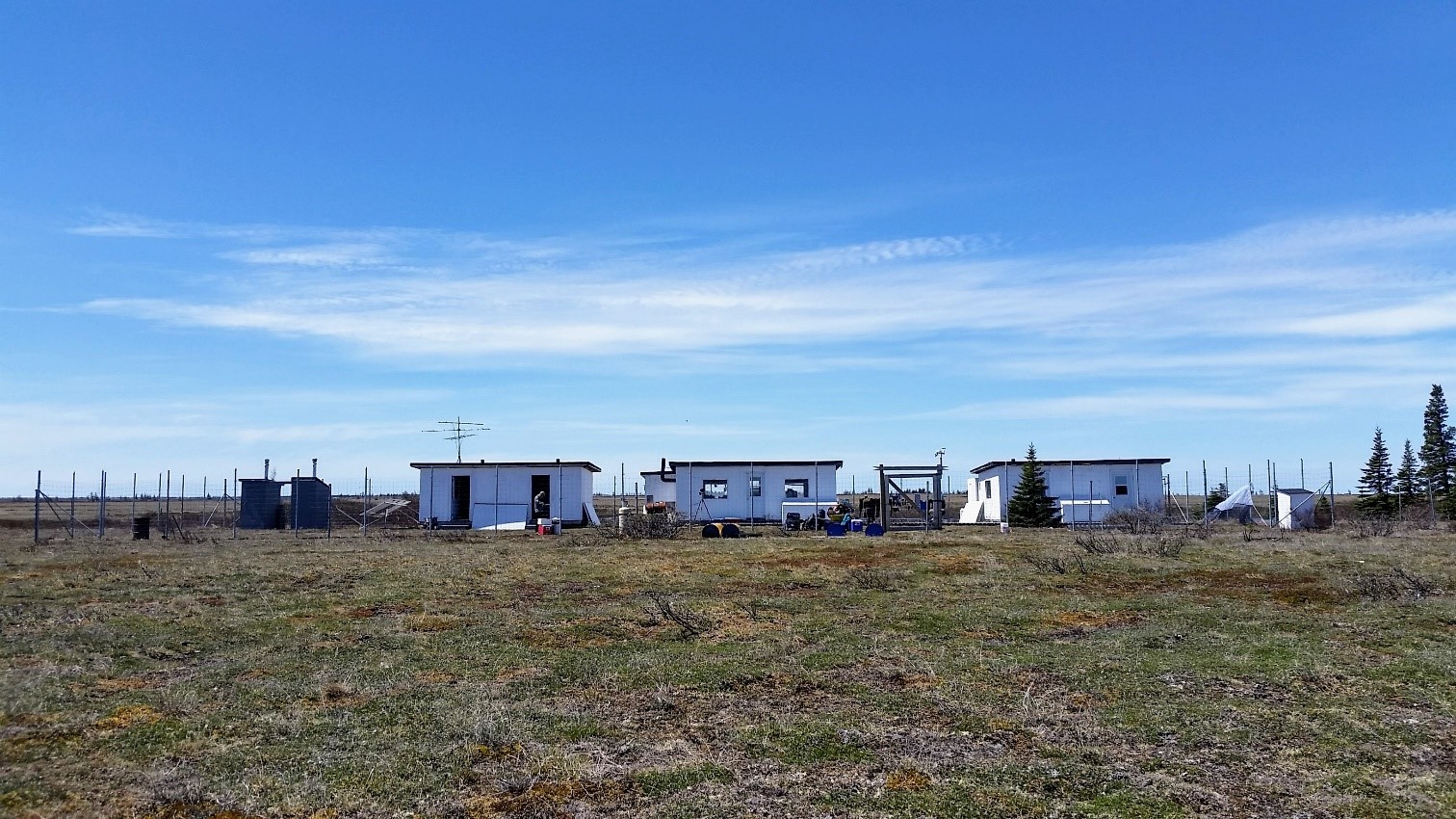
Burntpoint Creek in 2017 with new lab-storage building
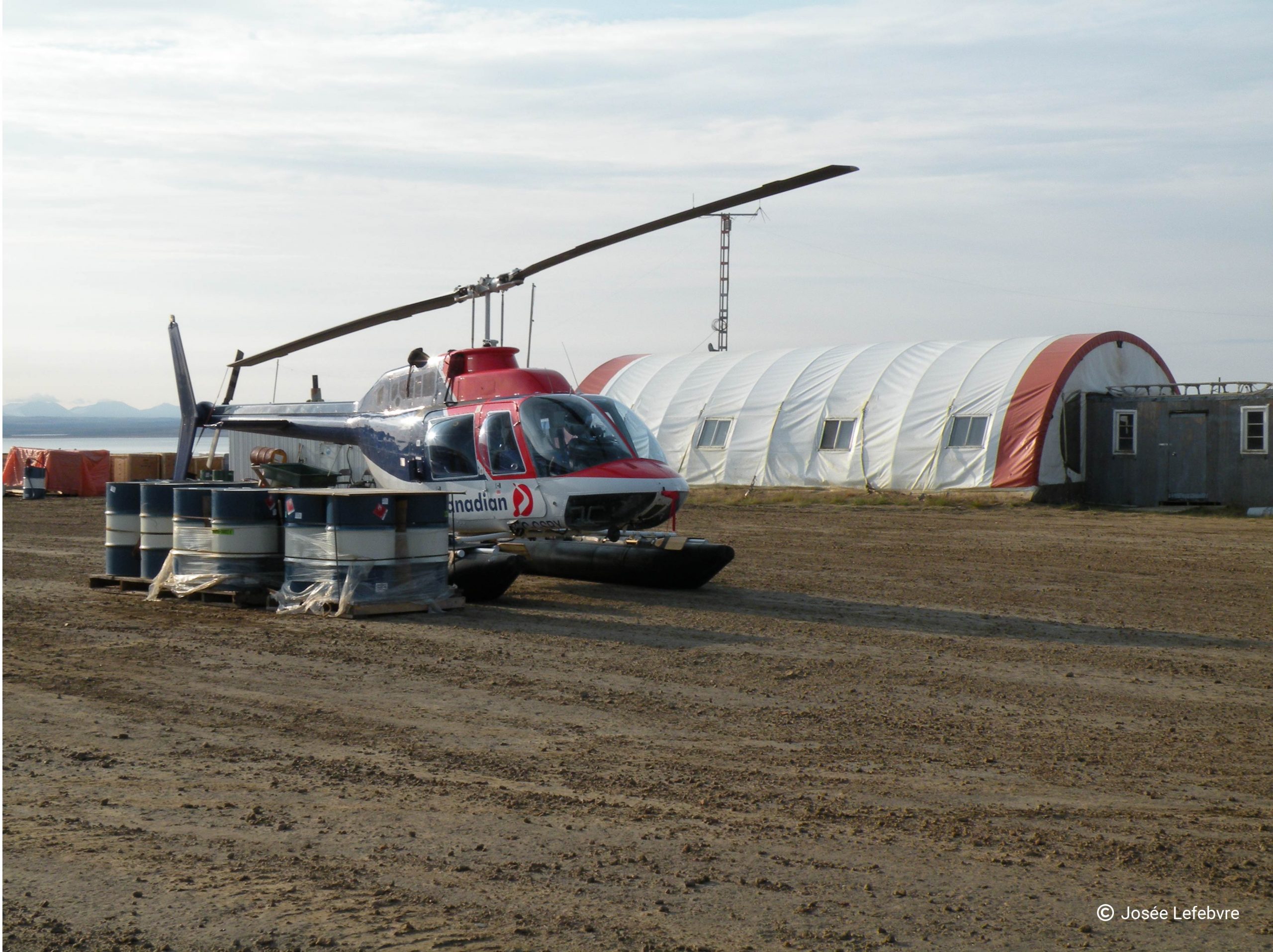
Eureka, Ellesmere Island 2007-2009
Eureka, Ellesmere Island 2007-2009
A research camp was established from 2007 to 2009 to explore a greater snow goose breeding area. Activities were conducted from Eureka at the old Polar Continental Shelf Project operational base. During this short period, the main activities were greater snow geese brood surveys and banding. At the same time, information was documented on small mammals, as well as predators (foxes and wolves), and nesting activities of other bird species.
